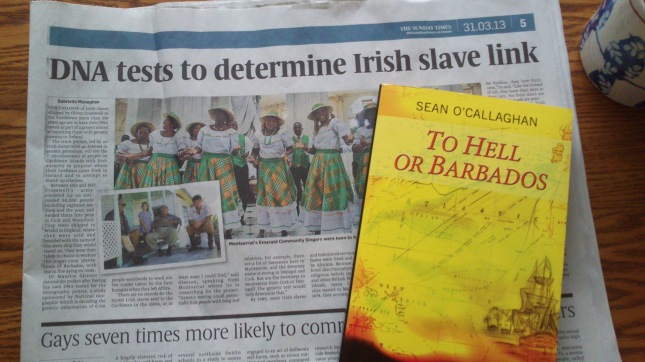
The story of the Irish slaves in the Caribbean will hopefully have some sort of a happy ending thanks to a new DNA project that hopes to connect them with living relatives in Ireland.
I was reading The Sunday Times yesterday when a story by Gabrielle Monaghan caught my eye.
She was writing about the Icara project which is to test the DNA of the descendants of Irish slaves living on the Caribbean islands.
The DNA of what now? Exactly.
I had that same reaction a few years ago when I was scanning the history section in the local bookshop and came across “To Hell or Barbados” by Sean O’Callaghan.
It turns out, over 50,000 men, women and children (including the elderly and priests) were shipped from Ireland to Barbados and Virginia between 1652 and 1659.
In the early days, some signed what were called ‘indentures’, agreeing to work on plantations in the belief that they would be given their own plot of land once their term of employment was over.
However, in 1652, an order was granted allowing the Commissioner of Ireland to round up anyone who was seen as a ‘danger’ to the Commonwealth, leading to men of all ranks – from landowner to soldier to farmer – being captured and shipped abroad.
With such a large number of men now gone, there were too many women left behind and so a further order was made allowing for them to be sent to Virginia or New England to work. Some plantation owners were also very keen to have Irish women shipped over to them on the islands.
It could take up to ten weeks to cross the Atlantic in the slave ships, with many of those on board (up to one in five according to Monaghan) dying en route. Those that survived were sold on arrival to plantation owners; the merchants earning cash, tobacco, cotton or some other colonial product for their human cargo.
While the treatment of these slaves varied depending on the plantation owner, by and large that treatment was appalling with lashings and beatings an everyday occurrence.
The result, as might be expected, were plots to kill plantation owners, to rebel and to escape.
Some of the escapees turned to the seas to find their living and one of the many fascinating facts contained in O’Callaghan’s book is that: “It is estimated that five per cent of the pirates operating in the Caribbean towards the end of the seventeenth century were Irish.” (This probably stuck in my mind as “Pirates of the Caribbean” had totally captured my imagination not long before I stumbled across “To Hell or Barbados”.)
I remember reading all of this and being utterly stopped in my tracks. I studied history so I’m aware of many of the flare-ups and clashes that occurred during Britain’s rein over Ireland but it had never – never – occurred to me that Irish people, my people, were rounded up like animals and sold as slaves.
There are very few records regarding the Irish slaves sent to the Caribbean. Many of them settled in Monserrat where the Icara project now aims to test the DNA of their descendants in a bid to find out which corner of the Emerald Isle they hailed from and, hopefully, connect them with any living family they have over here.
As somebody interested in tracing her own family tree and who was both shocked and moved by their story, I truly wish them well.
Gabrielle Monaghan’s article “DNA tests to determine Irish slave link” can be read via The Sunday Times (subscription needed).
“To Hell or Barbados: The ethnic cleansing of Ireland” by Sean O’Callaghan is published by Brandon.
aimee
November 2, 2014 at 7:59 pm
I cannot believe that people are not taught this in school. It is such a harrowing truth to discover especially because my family on both sides have a long line of irish descent. I am absolutely horrified to learn about his. there should be more emphasis on this as well as the african slave trade.